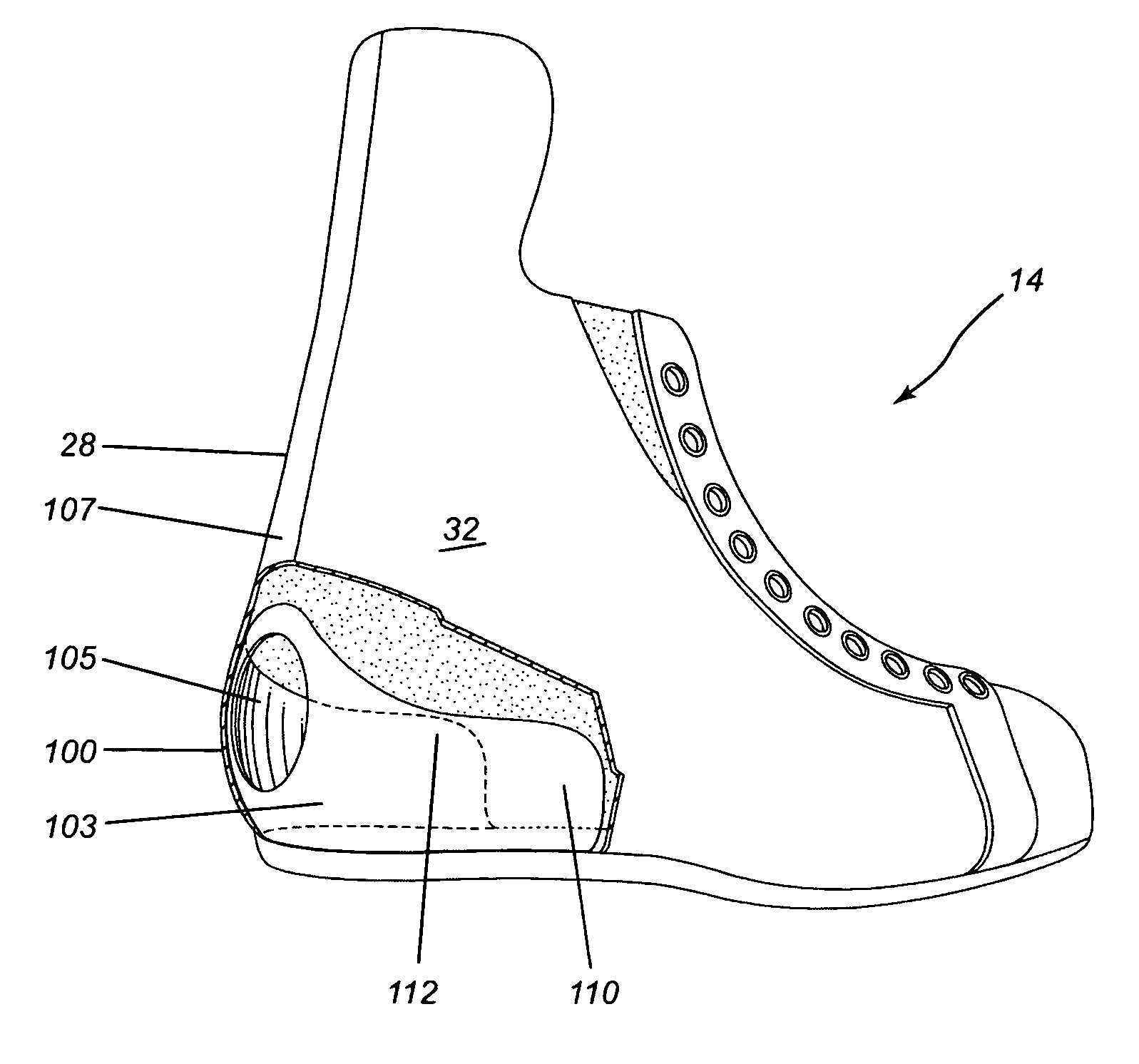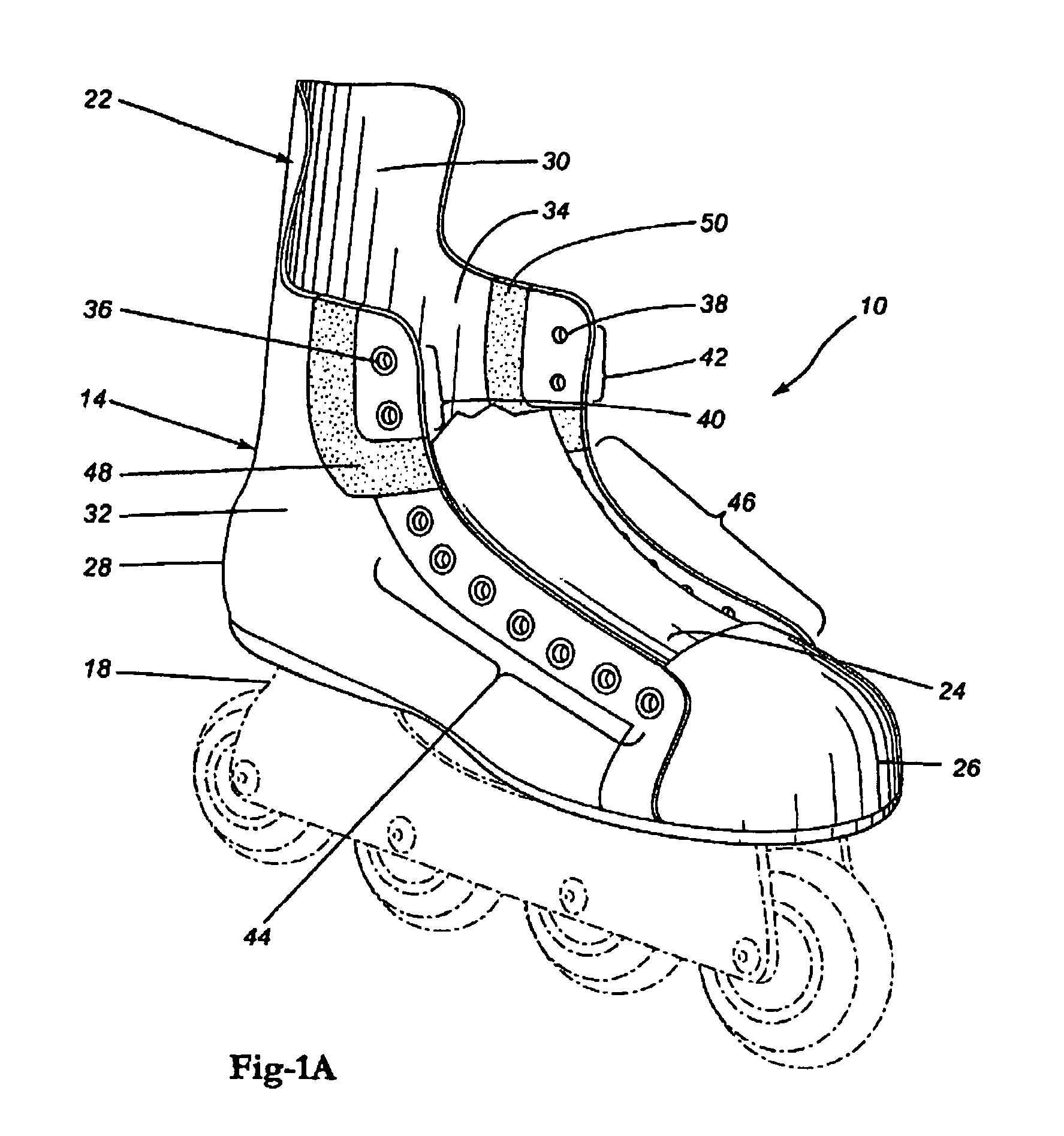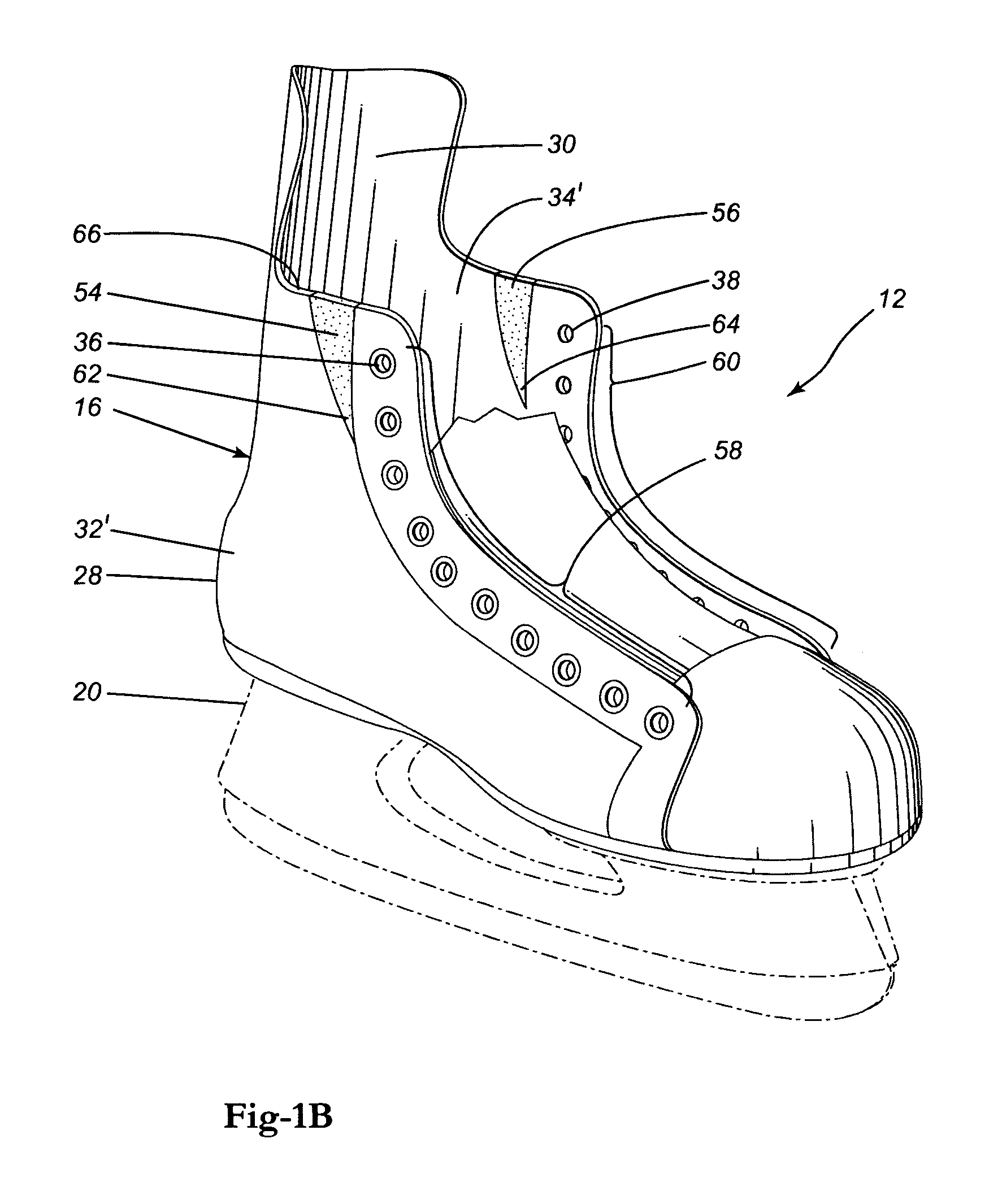However, because the lacing eyelets are fixed to the rigidly mounted side panels and
tendon guard which are not designed to bend, today's hockey skates are incapable of properly flexing forward or backward when providing full ankle support.
Because the continuous execution of more extreme biomechanical movements exceeds the
restricted range of motion provided by traditional skate boot constructions, such skating actions pinch the muscles and tendons in front of the ankle, and chafe the
skin and bone of the
heel, especially when skate boot laces are tied tightly.
However traditional skate boot designs have not changed much since they were first invented about 100 years ago.
Traditional skate boots utilize a composite one-piece upper which surrounds and supports the ankle, but, in doing so, does not allow for full ankle movement.
Such constructions only allow limited movement, depending on the deflection and flexibility characteristics of the construction materials used.
Today's more dynamic skating movements exceed the flexibility yield points of rigid skate boot materials, causing a rapid breakdown in the materials making up the side walls of conventional skate boots.
If this joint restriction is excessive, a skater will have to adapt with a change in skating technique that may create undue fatigue or a decrease in skating efficiency.
This indicates a problem in the design of conventional skate boots.
Anything that restricts either of these two movements will impede dorsiflexion of the foot.
Skate designs, such as most prior art skates, that do not allow advanced skaters to achieve such movement cause
irritation and sometimes permanent injury to the skater.
The most serious of these injuries involves the development of
heel spurs after intensive use of a restrictive skate boot.
However, the upper lacing on traditional skate boots is attached to a rigid
tendon guard which does not allow it, or the attached lacing, to stretch and travel with a leg that it leaning forward as a dorsiflexion of the foot is performed.
The resulting action, a rotation about this fulcrum, causes the
heel at the bottom end of the lever to lift upwards and backwards, jamming the heel against the heel support in the skate boot, in turn causing blistering to the heel in the short term.
A second cause of
irritation on the front of the
ankle region, called “lace-bite”, is also due to resistance to forward flexion of the leg over the front of the skate's upper lacing
system at more extreme angles of dorsiflexion, again during mid stride of the push phase of skating.
This natural swelling of the ankle further increases pressure against the rigidly mounted lacing
system, which is already causing pressure from resisting the action of the forward leaning shin.
However none of these methods provide full ankle flexion in combination with rigid lateral ankle support that is required for aggressive play.
This has either caused the patented design to fail entirely in real world testing, or has produced skate boots with limited movement resulting in unnecessary pressure and friction on various parts of the foot and leg when skating powerfully.
However the design of this skate is problematic for several reasons.
This is problematic as it requires a fixing of the athlete's ankle position, and this ankle position is different in every athlete.
More problematic, the
range of motion required for skating is limited by the design presented in these documents.
However this positioning leaves little room for backward movement of the cuffs track, necessary for forward flexion of the
cuff under dorsiflexion.
Furthermore, where as a traditional
tendon guard is one continuous piece, this design requires a split boot, which when leaned forward will cause the tendon guard to gap open, creating the potential to get full of
snow and wet.
Obstructing matter could also get jammed in the opening as well, preventing the boot from returning to its closed upright position.
Madore and Wright's foam side panels allow greater potential for dorsiflexion and
plantar flexion than most conventional skates, but are very soft and do not provide rigid lateral support required by aggressive professional players.
This design further compounds
crowding problems caused by
tissue expansion on the front of the foot when in a dorsiflexed position.
Felice's flexible / collapsible “Stove
pipe” tube, while different from Madore and Wright's skate describe in Canadian Pat. No. 2,328,569, still does not have any rigid lateral ankle support, and is capable of collapsing in any direction, not providing the lateral ankle stability required for hockey.
The design also has the same flaw that causes all traditional skates to loose ankle support with age, as the side panels are not designed to deform and deflect under forward or backward flexion.
While both the tendon guard on the back of this skate boot and the notched lacing systems on the front of this skate boot allow limited potential for forward flexion, the rigid one piece side panels connecting the latter and former do not.
The only way such designs can flex forward or aft is if the side panel bends, which eventually causes a breakdown in skate boot support.
This skate doesn't solve the problems of
irritation on the extensor hallucis longus, or the lack of flexibility in the tendon guard, which prevents the leg flap from fully pivoting as it should.
It also does nothing to improve
plantar flexion, prevent tongue slip, or address the asymmetrical positions of the anklebones.
Eliminating the ability to laterally rotate the ankle, which is required by this design, would make advanced skating impossible.
Moreover the design makes it impossible to secure the upper ankle properly.
It's also too heavy and has many elastically loaded moving armor parts which are subject to lifting and jamming while in play.
However the hard plastic constructions required separate interior bladders or liners which deprive the skater of the fit and feel required for advanced performance.
However, because they are designed as separate units, they are prone to slipping inside the shell.
No prior art has been able to achieve increased ankle mobility without a separate removable bladder.
The skates described in these four patents also lack the additional lateral ankle support required by top hockey players.
None of the prior art cited hereinabove provides for a skate boot which is effective for the low hip, high dorsiflexion, power skating position of advanced skaters.
The prior art either lacks flexibility, rigid lateral support, is too stiff, is too heavy, requires a separate bladder, is ineffective, or is too expensive to manufacture.
 Login to View More
Login to View More  Login to View More
Login to View More 


